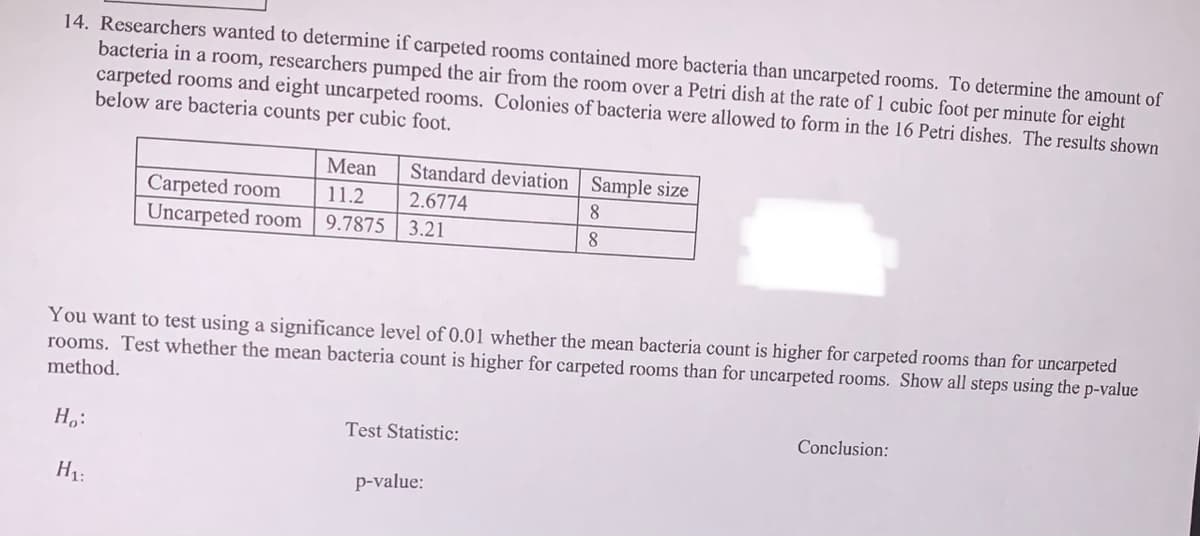14. Researchers wanted to determine if carpeted rooms contained more bacteria than uncarpeted rooms. To determine the amount of bacteria in a room, researchers pumped the air from the room over a Petri dish at the rate of 1 cubic foot per minute for eight carpeted rooms and eight uncarpeted rooms. Colonies of bacteria were allowed to form in the 16 Petri dishes. The results shown below are bacteria counts per cubic foot. Mean Standard deviation Sample size Carpeted room Uncarpeted room 11.2 2.6774 8. 9.7875 3.21 8 You want to test using a significance level of 0.01 whether the mean bacteria count is higher for carpeted rooms than for uncarpeted rooms. Test whether the mean bacteria count is higher for carpeted rooms than for uncarpeted rooms. Show all steps using the p-value method. H.: Test Statistic: Conclusion: H1: p-value:
14. Researchers wanted to determine if carpeted rooms contained more bacteria than uncarpeted rooms. To determine the amount of bacteria in a room, researchers pumped the air from the room over a Petri dish at the rate of 1 cubic foot per minute for eight carpeted rooms and eight uncarpeted rooms. Colonies of bacteria were allowed to form in the 16 Petri dishes. The results shown below are bacteria counts per cubic foot. Mean Standard deviation Sample size Carpeted room Uncarpeted room 11.2 2.6774 8. 9.7875 3.21 8 You want to test using a significance level of 0.01 whether the mean bacteria count is higher for carpeted rooms than for uncarpeted rooms. Test whether the mean bacteria count is higher for carpeted rooms than for uncarpeted rooms. Show all steps using the p-value method. H.: Test Statistic: Conclusion: H1: p-value:
Glencoe Algebra 1, Student Edition, 9780079039897, 0079039898, 2018
18th Edition
ISBN:9780079039897
Author:Carter
Publisher:Carter
Chapter10: Statistics
Section10.3: Measures Of Spread
Problem 26PFA
Related questions
Topic Video
Question
Please show all work. Thank you so much.

Transcribed Image Text:14. Researchers wanted to determine if carpeted rooms contained more bacteria than uncarpeted rooms. To determine the amount of
bacteria in a room, researchers pumped the air from the room over a Petri dish at the rate of 1 cubic foot per minute for eight
carpeted rooms and eight uncarpeted rooms. Colonies of bacteria were allowed to form in the 16 Petri dishes. The results shown
below are bacteria counts per cubic foot.
Mean
Standard deviation | Sample size
Carpeted room
Uncarpeted room
11.2
2.6774
9.7875 3.21
8.
8
You want to test using a significance level of 0.01 whether the mean bacteria count is higher for carpeted rooms than for uncarpeted
rooms. Test whether the mean bacteria count is higher for carpeted rooms than for uncarpeted rooms. Show all steps using the p-value
method.
H,:
Test Statistic:
Conclusion:
H1:
p-value:
Expert Solution
This question has been solved!
Explore an expertly crafted, step-by-step solution for a thorough understanding of key concepts.
This is a popular solution!
Trending now
This is a popular solution!
Step by step
Solved in 3 steps with 2 images

Knowledge Booster
Learn more about
Need a deep-dive on the concept behind this application? Look no further. Learn more about this topic, statistics and related others by exploring similar questions and additional content below.Recommended textbooks for you

Glencoe Algebra 1, Student Edition, 9780079039897…
Algebra
ISBN:
9780079039897
Author:
Carter
Publisher:
McGraw Hill

Glencoe Algebra 1, Student Edition, 9780079039897…
Algebra
ISBN:
9780079039897
Author:
Carter
Publisher:
McGraw Hill